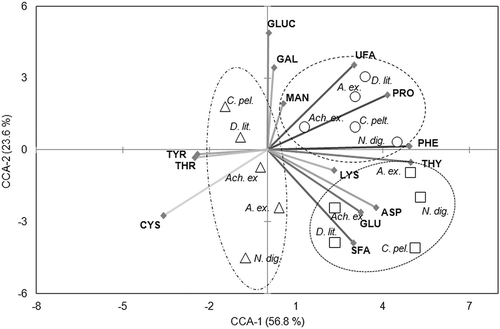Figures & data
Fig. 1. Temporal variations in carbohydrate (A‒D) and lipid (E–H) concentrations for Achnanthes exigua (▀), Amphora exigua (▴), Cocconeis peltoides (◯), Diploneis littoralis () and Navicula digitoradiata (◊) at PAR, PAR + UV-A, PAR + UV-B and PAR + UV-A + UV-B, through initial, short- (6 h) and long-term experiments (30 days).
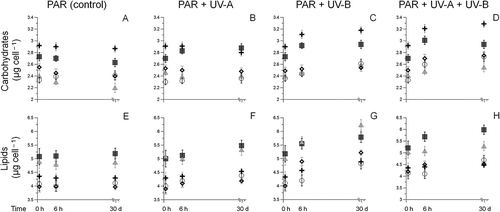
Fig. 2. Variations in the main carbohydrate concentrations (mean ± SD) for (A) Achnanthes exigua, (B) Amphora exigua, (C) Cocconeis peltoides, (D) Diploneis littoralis and (E) Navicula digitoradiata at the start of the experiments at 20 °C (PAR = 600 µmol photons m−2 s−1).

Fig. 3. Temporal variations in relative carbohydrate compositions of (A, B) Achnanthes exigua, (C, D) Amphora exigua, (E, F) Cocconeis peltoides, (G, H) Diploneis littoralis and (I, J) Navicula digitoradiata at PAR, PAR + UV-A, PAR + UV-B and PAR + UV-A + UV-B, during 6-h (A, C, E, G, I) and 30-day (B, D, F, H, J) experiments.
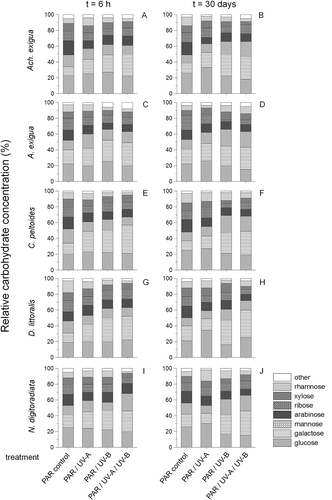
Fig. 4. Variations in the free fatty acid concentrations (mean ± SD) for Achnanthes exigua, Amphora exigua, Cocconeis peltoides, Diploneis littoralis and Navicula digitoradiata at the start of the experiments at 20 °C (PAR = 600 µmol photons m–2 s–1).
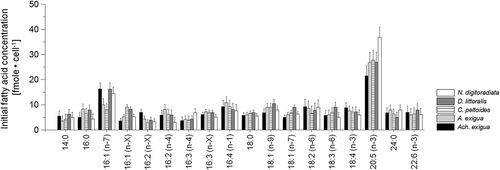
Fig. 5. Temporal variation in relative free fatty acid compositions of (A, B) Achnanthes exigua, (C, D) Amphora exigua, (E, F) Cocconeis peltoides, (G, H) Diploneis littoralis and (I, J) Navicula digitoradiata at PAR, PAR+UV-A, PAR+UV-B and PAR+UV-A+UV-B, during 6-h (A, C, E, G, I) and 30-day (B, D, F, H, J) experiments.
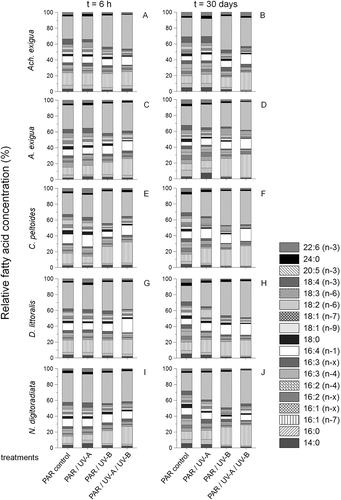
Fig. 6. Variations in the main free amino acid concentrations (mean ± SD) for (A) Achnanthes exigua, (B) Amphora exigua, (C) Cocconeis peltoides, (D) Diploneis littoralis and (E) Navicula digitoradiata at the start of the experiments at 20 °C (PAR = 600 µmol photons m−2 s−1).

Fig. 7. Temporal variations in relative free amino acid compositions of (A, B) Achnanthes exigua, (C, D) Amphora exigua, (E, F) Cocconeis peltoides, (G, H) Diploneis littoralis and (I, J) Navicula digitoradiata at PAR, PAR+UV-A, PAR+UV-B and PAR+UV-A+UV-B during 6-h (A, C, E, G, I) and 30-day (B, D, F, H, J) experiments.

Fig. 8. Temporal variations in proline dependent enzyme activities (U) (mean ± SD) of, (A-B) P5CS, (C-D) P5CR and (E-F) δ-OAT for Achnanthes exigua, Amphora exigua, Cocconeis peltoides, Diploneis littoralis and Navicula digitoradiata at PAR, PAR+UV-A, PAR+UV-B and PAR+UV-A+UV-B, during 6-h (A, C, E) and 30-day (B, D, F) experiments.

Table 1. Non-parametric Spearman rank correlations (rs-values) for physiological variables measured for five diatom species after 30 days’ exposure to PAR/UV-A, PAR/UV-B and PAR/UV-A/UV-B. Significance level (P values) * < 0.05, ** < 0.01, *** < 0.001. Abbreviations: ARA: arabinose, ASP: aspartic acid, CYS: cysteine, GAL: galactose, GLU: glutamic acid, GLUC: glucose, LYS: lysine, MAN: mannose, RAH: rhamnose, PHE: phenylalanine, PRO: proline, UFA: unsaturated fatty acids, RIB: ribose, SFA: saturated fatty acids, THR: threonine, TRY: tryptophan, TYR: tyrosine, UFA: unsaturated fatty acids, XYL: xylose, n.s.: not significant (α < 0.05).
Fig. 9. Canonical correspondence analysis plot of Axes 1 and 2 showing species groupings of Achnanthes exigua (Ach. ex.), Amphora exigua (A. ex.), Cocconeis peltoides (C. pel.), Diploneis littoralis (D. lit.) and Navicula digitoradiata (N. dig.) in relation to 14 physiological variables measured at □ PAR + UV-A, ○ PAR+UV-B and ∆ PAR+UV-A+UV-B during a 30-day experiment. The lengths of the arrows represent the relative importance of different variables in explaining species distributions, while the angles of the arrows relative to the axes and to other variables indicate the strength of their correlations. Abbreviations: ASP: aspartic acid, CYS: cysteine, GAL: galactose, GLU: glutamic acid, GLUC: glucose, LYS: lysine, MAN: mannose, PHE: phenylalanine, PRO: proline, SFA: saturated fatty acids, THR: threonine, THY: tryptophan, TYR: tyrosine, UFA: unsaturated fatty acids.
